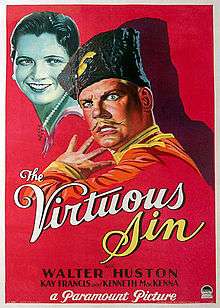The Virtuous Sin
| The Virtuous Sin | |
|---|---|
 Original poster | |
| Directed by |
George Cukor Louis J. Gasnier |
| Written by |
Martin Brown Louise Long Based on a play by Lajos Zilahy |
| Starring |
Walter Huston Kay Francis Kenneth MacKenna |
| Music by |
Sam Coslow Ralph Rainger |
| Cinematography | David Abel |
| Edited by | Otho Lovering |
| Distributed by | Paramount Pictures |
Release dates |
|
Running time | 80 minutes |
| Country | United States |
| Language | English |
The Virtuous Sin is a 1930 American Pre-Code comedy-drama film directed by George Cukor and Louis J. Gasnier. The screenplay by Martin Brown and Louise Long is based on the play The General by Lajos Zilahy.
Plot
Marya is the wife of medical student Victor Sablin, who finds it impossible to deal with military life when he is inducted into the Russian army during World War I. With her husband is sentenced to death by firing squad due to his insubordination, Marya offers herself to General Gregori Platoff in order to save him. When the two unexpectedly fall in love, Victor — not caring that his life has been spared — threatens to kill his rival. His determination to eliminate the general falters when Marya confesses she is not in love with her husband — and never was.
Cast
- Walter Huston as Gen. Gregori Platoff
- Kay Francis as Marya Sablin
- Kenneth MacKenna as Victor Sablin
Critical reception
Mordaunt Hall of the New York Times called the film "a clever comedy with a splendid performance by Walter Huston" and added, "There is a constant fund of interest in this picture's action. It is one of those rare offerings in which youth takes a back seat.[1]
George Cukor's reflection in 1972
In the book On Cukor, director George Cukor confided to biographer Gavin Lambert: "It wasn't much good. I'd be in great shock if they [film restorationists & historians] rescued this one. I remember that I enjoyed working with Kay Francis and Walter Huston, though."[2]
Preservation status
A complete print of this film is held by the UCLA Film and Television Archive. However, the UCLA archive's website says the print is too shrunken for projection.[3]